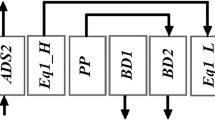Abstract
The production of biomethane from biogas offers the possibility to obtain chemical resources fuels from combustion engines, gas turbine and fuel cells. However, each biomethane application requires specific treatment. This work is focused on the removal of CO2 from biogas as a fundamental step in biogas treatment. A laboratory scale PSA unit is introduced in this paper. The extruded activated carbon was used to construct the fixed bed adsorption layer. The maximum sorption capacity of CO2 was determined from the adsorption isotherm of pure CO2 carried out in a high pressure thermogravimeter. Breakthrough curves of CO2 and CH4 were determined for different volumetric flows of feed. The results were applied for the optimisation of PSA time in order to maximalize the suppression of CO2 from upgrading CH4. The concentration of CH4 is more than 98 % after the upgrading process. The total efficiency of the process was 77 %.








Similar content being viewed by others
References
Ajhar M, Melin T (2006) Siloxane removal with gas permeation membranes. Desalination 200:234–235. doi:10.1016/j.desal.2006.03.308
Bai BCh, Cho S, Yu HR, Yi KB, Kim KD, Lee YS (2013) Effect of aminated carbon molecular sieves on breakthrough curve behaviour in CO2/CH4 separation. J Ind Eng Chem 19:776–783. doi:10.1016/j.jiec.2012.10.016
Bauer A, Leonhartsberger Ch, Bosch P, Amon B, Friedl A, Amon T (2008) Analysis of methane yields from energy crops and agricultural by-products and estimation of energy potential from sustainable crop rotation systems in EU-27. Clean Technol Environ Policy 12:153–161. doi:10.1007/s10098-009-0236-1
Bonnot K, Tondeur D, Luo LA (2006) Effect of composition, temperature and purge on the performance of the cyclic adsorption of CO2 and CH4 on activated carbon. Chem Eng Res Des 84:192–208. doi:10.1205/cherd.03357
Brunauer SP, Emmett H, Teller AE (1938) Adsorption of gases in multimolecular layers. J Am Chem Soc 60:309–319. doi:10.1021/ja01269a023
Cavenatti S, Grande CA, Rodrigues AE (2004) Adsorption equilibrium of methane, carbon dioxide and nitrogen on zeolite 13X at high pressure. J Chem Eng Data 49:1095–1101. doi:10.1021/je0498917
Cheng T, Jiang Y, Zhang Y, Liu S (2004) Prediction of breakthrough curves for adsorption on activated carbon fibers in a fixed bed. Carbon 42:3081–3085. doi:10.1016/j.carbon.2004.07.021
Cozma P, Wukovits W, Mamaliga I, Friedl A, Gavrilescu M (2014) Modeling and simulation if high pressure water scrubbing technology applied for biogas upgrading. Clean Technol Environ Policy. doi:10.1007/s10098-014-0787-7
Geankoplis CJ (1993) Transport processes and unit operations, 3rd edn. Prentice-Hall, New Jersey, pp 697–704
Grant RJ, Manes M, Smith JB (1962) Adsorption of normal paraffins and sulfur compounds on activated carbon. AIChE J 8:403–406. doi:10.1002/aic.690080328
Horikawa MS, Rossi F, Gimenes ML, Costa CMM, da Silva MGC (2004) Chemical absorption of H2S for biogas purification. Braz J Chem Eng 21:415–422
Klemes J, Bulatov I (2008) Towards cleaner technologies minimising the environmental impact. Clean Technol Environ Policy 10:107–110. doi:10.1007/s10098-008-0149-4
Kubonova L, Obalova L, Vlach O, Troppova I, Kalousek J (2011) Modelling of NO adsorption in fixed bed on activated carbon. Chem Process Eng 32:367–377. doi:10.2478/v10176-011-0029-z
Langmuir I (1916) The constitution and fundamental properties of solids and liquids. Part I. Solids. J Am Chem Soc 38:2221–2295. doi:10.1021/ja02268a002
Liu AM, Xu SS, Lu CL, Peng P, Zhang YY, Feng DS, Liu YY (2014) Anaerobic fermentation by aquatic product wastes and other auxiliary materials. Clean Technol Environ Policy 16:415–421. doi:10.1007/s10098-013-0640-4
McCabe WL, Smith JC, Harriott P (2001) Unit operations of chemical engineering, 6th edn. McGraw-Hill, New York, pp 812–821
Navarro AR, Rubio MC, Maldonado MC (2012) A combined process to treat lemon industry wastewater and produce biogas. Clean Technol Environ Policy 14:41–45. doi:10.1007/s10098-011-0373-1
Pipatmanonai S, Kaewluan S, Tharapong V (2009) Economic assessment of biogas-to-electricity generation system with H2S removal by activated carbon in small pig farm. Appl Energy 86:669–674. doi:10.1016/j.apenergy.2008.07.007
Puksec T, Neven D (2012) Economic viability and geographic distribution of centralized biogas plants: case study Croatia. Clean Technol Environ Policy 14:427–433. doi:10.1007/s10098-012-0460-y
Rashidi NA, Yusup S, Loong LH (2013) Kinetic study on carbon dioxide using activated carbon. Chem Eng Trans 35:361–366. doi:10.3303/CET1335060
Ruthven DM (1984) Principles of adsorption and adsorption processes. Wiley, New York, USA
Ruthven DM, Farooq S, Knaebel KS (1993) Pressure swing adsorption. VCH Publisher, New York
Ryckebosh E, Drouillon M, Vervaeren H (2011) Techniques for transformation of biogas to biomethane. Biomass and Bioenergy 35:1633–1645. doi:10.1016/j.biombioe.2011.02.033
Santos MS, Grande CA, Rodrigues AE (2011) New cycle configuration to enhance performance of kinetic PSA processes. Chem Eng Sci 66:1590–1599. doi:10.1016/j.ces.2010.12.032
Seader JD, Henley EJ (1998) Separation process principles. Wiley, New York
Senthil KP, Gayathri AR (2009) Adsorption of Pb2+ ions from aqueous solutions onto bael tree leaf powder: isotherms, kinetics and thermodynamics study. J Eng Sci Technol 4:381–399
Acknowledgments
The authors gratefully acknowledge financial support of the project “Excellent Young Researcher at BUT” No. CZ.1.07/2.3.00/30.0039 and the Project ICT at VŠB TU Ostrava No. ED2.1.00/03.0082 and LO1406.
Conflict of interest
The authors declare that they have no conflict of interest.
Author information
Authors and Affiliations
Corresponding author
Rights and permissions
About this article
Cite this article
Lestinsky, P., Vecer, M., Navratil, P. et al. The removal of CO2 from biogas using a laboratory PSA unit: design using breakthrough curves. Clean Techn Environ Policy 17, 1281–1289 (2015). https://doi.org/10.1007/s10098-015-0912-2
Received:
Accepted:
Published:
Issue Date:
DOI: https://doi.org/10.1007/s10098-015-0912-2




